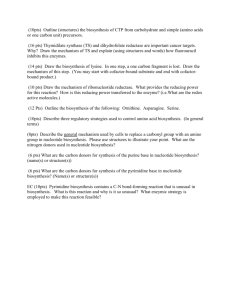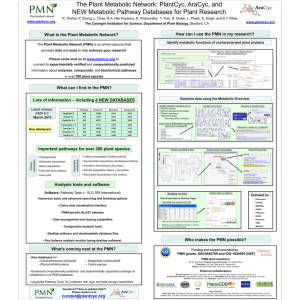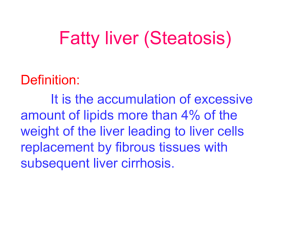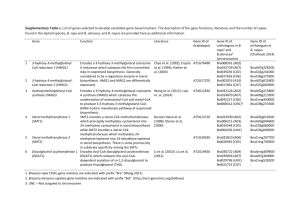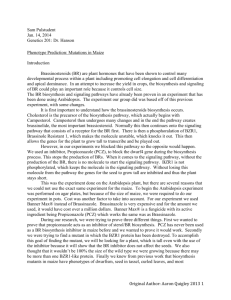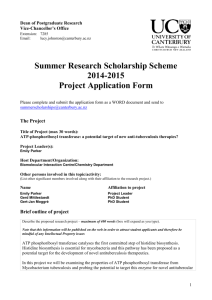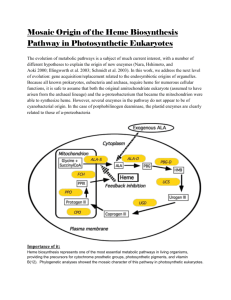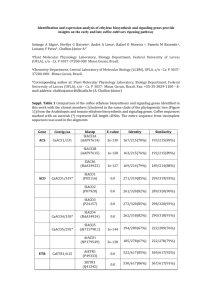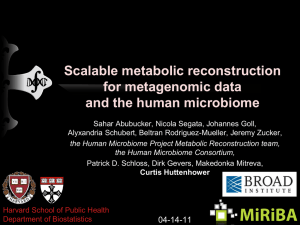bit_22010_sm_Supplementary_Appendix_3
advertisement
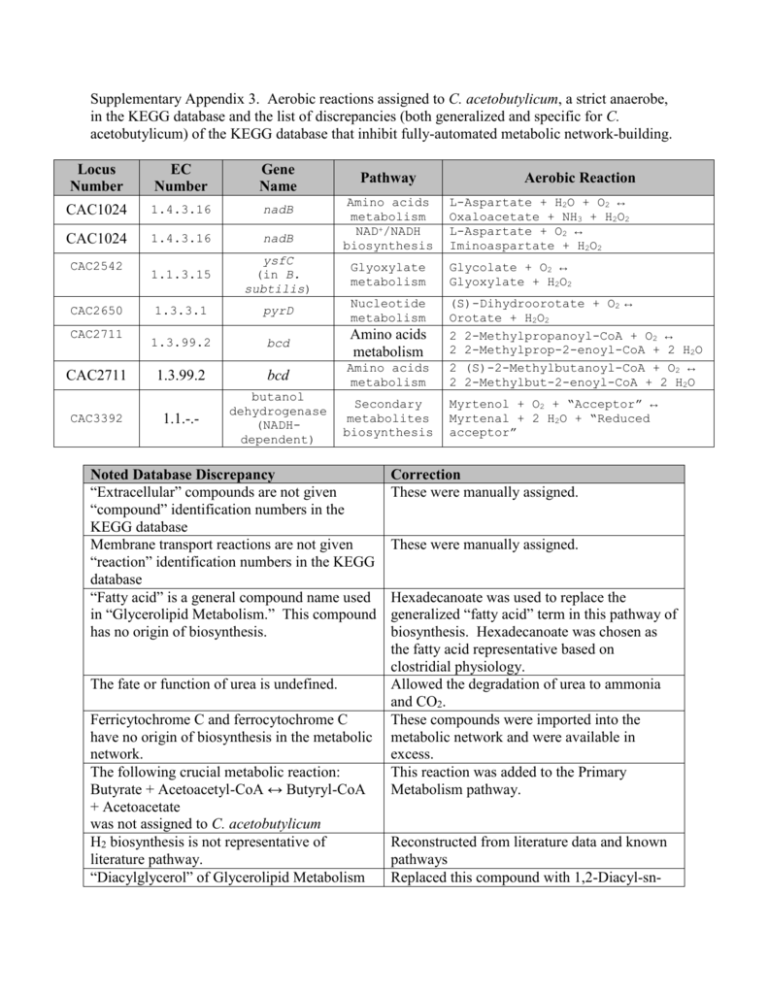
Supplementary Appendix 3. Aerobic reactions assigned to C. acetobutylicum, a strict anaerobe, in the KEGG database and the list of discrepancies (both generalized and specific for C. acetobutylicum) of the KEGG database that inhibit fully-automated metabolic network-building. Locus Number EC Number Gene Name CAC1024 1.4.3.16 nadB CAC1024 1.4.3.16 nadB 1.1.3.15 ysfC (in B. subtilis) Glyoxylate metabolism Glycolate + O2 ↔ Glyoxylate + H2O2 1.3.3.1 pyrD Nucleotide metabolism 1.3.99.2 bcd Amino acids metabolism 1.3.99.2 bcd Amino acids metabolism (S)-Dihydroorotate + O2 ↔ Orotate + H2O2 2 2-Methylpropanoyl-CoA + O2 ↔ 2 2-Methylprop-2-enoyl-CoA + 2 H2O 2 (S)-2-Methylbutanoyl-CoA + O2 ↔ 2 2-Methylbut-2-enoyl-CoA + 2 H2O 1.1.-.- butanol dehydrogenase (NADHdependent) Secondary metabolites biosynthesis CAC2542 CAC2650 CAC2711 CAC2711 CAC3392 Pathway Amino acids metabolism NAD+/NADH biosynthesis Noted Database Discrepancy “Extracellular” compounds are not given “compound” identification numbers in the KEGG database Membrane transport reactions are not given “reaction” identification numbers in the KEGG database “Fatty acid” is a general compound name used in “Glycerolipid Metabolism.” This compound has no origin of biosynthesis. The fate or function of urea is undefined. Ferricytochrome C and ferrocytochrome C have no origin of biosynthesis in the metabolic network. The following crucial metabolic reaction: Butyrate + Acetoacetyl-CoA ↔ Butyryl-CoA + Acetoacetate was not assigned to C. acetobutylicum H2 biosynthesis is not representative of literature pathway. “Diacylglycerol” of Glycerolipid Metabolism Aerobic Reaction L-Aspartate + H2O + O2 ↔ Oxaloacetate + NH3 + H2O2 L-Aspartate + O2 ↔ Iminoaspartate + H2O2 Myrtenol + O2 + “Acceptor” ↔ Myrtenal + 2 H2O + “Reduced acceptor” Correction These were manually assigned. These were manually assigned. Hexadecanoate was used to replace the generalized “fatty acid” term in this pathway of biosynthesis. Hexadecanoate was chosen as the fatty acid representative based on clostridial physiology. Allowed the degradation of urea to ammonia and CO2. These compounds were imported into the metabolic network and were available in excess. This reaction was added to the Primary Metabolism pathway. Reconstructed from literature data and known pathways Replaced this compound with 1,2-Diacyl-sn- has no degradation reactions. Valine, Leucine, Isoleucine, Histidine, Cysteine and aromatic amino acids degradation pathways are largely incomplete. glycerol. Made the assumption that amino acids are not degraded for energy and that amino acids were only incorporated into protein or used as building-blocks for other macromolecules. Conversion of Riboflavin to Dimethyl This reaction pathway was eliminated. The benzimidazole is undefined. pathway was redirected to terminate with FAD biosynthesis. Octaprenyl-diphosphate has no defined origin Geranyl-diphosphate was synthesized through of biosynthesis. the non-mevalonate pathway of steroids biosynthesis and processed to a farnesyldiphosphate intermediate, then directly to octaprenyl-diphosphate. The reaction mechanism and associated The following composite reaction was enzymes for the conversion of Glyceraldehyde- composed, based on published data (Begley et al. 1999). 3-phosphate and Pyruvate to 5-(2Hydroxyethyl)-4-methylthiazole in the Pyruvate + Glyceraldehyde-3-phosphate + Thiamine biosynthesis pathway is Glycine + L-Cysteine → 5-(2required but undefined. Hydroxyethyl)-4-methylthiazole + LAlanine + 3 H2O + CO2 The cytosine-specific DNA methyltransferase (e.c. 2.1.1.37, CAC1222, CAC1501) has associated reaction mechanism: The reaction in question was eliminated. SAdenosyl-L-homocysteine is a byproduct of one path of L-Methionine production and S-Adenosyl-L-methionine + DNA cytosine Menaquinone biosynthesis. It is converted to ↔ S-Adenosyl-L-homocysteine L-Homocysteine through an S-D-Ribosyl-L+ DNA 5-methylcytosine. homosysteine intermediate with D-Ribose and Both DNA cytosine and DNA 5Adenine byproducts. methylcytosine have no origins of biosynthesis or degradation. The compounds “Iron,” “Fe2+,” and “Fe3+” all have separate identifiers. No degradation pathway exists for 3oxopropanoate. “Iron” and “Fe2+” were grouped under the same identifier. “Fe3+” was given a separate identifier. Conversion to Acetaldehyde and CO2 was added based on the similar organism C. tetani E88. The Biotin-carboxyl-carrier protein required of fatty acid biosynthesis is synthesized from Biotin and requires an “Apo-[carboxylase].” This compound has no root-origin of biosynthesis or defined chemical composition. The Biotin-carboxyl-carrier protein is involved in a cycle that results in the conversion of Acetyl-CoA to Malonyl-CoA at the expense of ATP. Due to the unknown (R-group) structure of this protein in clostridia and its cycling nature as a carrier compound (rather than a macromolecule precursor), a simplification was made for its biosynthesis: Biotinyl-5’-AMP ↔ AMP + Biotin-carboxylcarrier protein (Holo-[carboxylase]). In Glycerolipid biosynthesis, there is a For the “acyl” group, hexadecanoate was used, requirement of “Acyl-CoA,” but this based on clostridial physiology. The following compound does not have an origin of reaction was created to define “Acyl-CoA” in biosynthesis. the original KEGG pathways: Hexadecanoate + CoA ↔ Acyl-CoA + H2O The following reaction was added to the The compounds “-D-fructose 1,6biphosphate” and “D-fructose 1,6-biphosphate” metabolic network to allow the unconstrained exchange between these two identical are given separate identifiers in KEGG. compounds: -D-fructose 1,6-biophosphate ↔ D-fructose 1,6-biphosphate The following reaction was added to the The compounds “-D-fructose 6-phosphate” metabolic network to allow the unconstrained and “D-fructose 6-phosphate” are given exchange between these two identical separate identifiers in KEGG. compounds: -D-fructose 6-phosphate ↔ D-fructose 6phosphate Peptidoglycan biosynthesis is missing certain A broad approximation was formulated: key enzymes that are not recognized in UDP-N-acetylmuramoyl-L-alanyl-D-glutamate clostridia through homology. + 3 ATP + H2O + NH3 + L-Lysine + 5 Glycine + D-Aanyl-D-alanine + UDP_N-Acetyl_Dglucosamine ↔ Peptidoglycan KEGG does not support the biosynthesis of A composite reaction was formulated from an Wall Teichoic acid, an essential earlier publication (Heinemann et al. 2005): macromolecular component of the bacterial 41 UDP-N-Acetylglucosamine + 3 CDP cell wall. glycerol + 40 CDP ribitol + 2 D-Alanine + 2 ATP ↔ Wall Teichoic acid + 40 UDP + 43 CMP + 2 AMP + 2 Pyrophosphate KEGG does not support the biosynthesis of A composite reaction was formulated from an Lipoteichoic acid, an essential macromolecular earlier publication (Heinemann et al. 2005): component of the bacterial cell wall. 48 Phosphatidylglycerol + Glycerophosphoglycoglycerolipid + 33 DAlanine + 7 N-Acetyl-D-glucosamine-c55 ↔ Lipoteichoic acid + 48 1,2-Diacylglycerol + 33 AMP + 33 Orthophosphate The compounds “D-Glucose,” “α-D-Glucose” and “β-D-Glucose” are given separate identifiers in KEGG. Ferredoxin has no origin of biosynthesis or degradation. Thioredoxin has no origin of biosynthesis or degradation Folate biosynthesis involves the production of species (e.g., Molybdopterin) that do not contain defined synthesis or degradation pathways. The previously presented equations for Lipoteichoic acid and Wall Teichoic acid are possibly creating a large burden of macromolecular biosynthesis and inhibiting growth rate in silico. The following important reaction is contained in KEGG that involves two generalized terms (“2-Oxo acid” and “L-Amino acid”). Neither of the generalized terms contains an origin of biosynthesis/degradation. L-Ornithine + 2-Oxo acid ↔ L-Glutamate 5semialdehyde + L-Amino acid The compounds “Starch,” “Dextrin,” “Amylose,” and “Cellulose” are broadly defined as polymer chains of length n. A clostridial enzyme exists for the reversible conversion of α-D-Glucose to β-D-Glucose. The following reaction was added so “DGlucose” could be utilized in glycolysis: α-D-Glucose ↔ D-Glucose Ferredoxin has reduced and oxidized states that stay in balance given an electrochemical potential. To provide origins of biosynthesis/degradation, reduced ferredoxin was imported into the metabolic network and retained as part of the pooled solutes. To provide origins of biosynthesis/degradation, reduced thioredoxin was imported into the metabolic network and retained as part of the pooled solutes. A lumped reaction was generated for folate biosynthesis and was based on a simplified version of the biosynthesis pathway: GTP + H2O + 4-Aminobenzoate + LGlutamate + NAD+ + ATP ↔ Folate + Formate + Glycoaldehyde + ADP + NADH + H+ + 2 Orthophosphate + 2 Pyrophosphate It is possible that the un-cross-linked forms of these species are represented in the biomass equation. Comparisons were made to B. subtilis (Atrih et al. 1999; Perego et al. 1995). 1. UDP-N-Acetoglucosamine + CDP-Ribitol ↔ Wall Teichoic acid 2. Phosphatidylglycerol + Glycerophosphoglycerolipid + D-alanine ↔ Lipoteichoic acid Through the combination of BLAST and enzymatic database searches (BRENDA), Pyruvate was found a suitable “2-Oxo acid” and L-Alanine was the corresponding “LAmino acid.” This combination produced Eq. 1 of the manuscript. Since a clostridial minimal medium was used, these compounds were not included in the current metabolic network reconstruction. However, these compounds and their degradation reactions must be specifically defined before their inclusion in a metabolic network is feasible.
